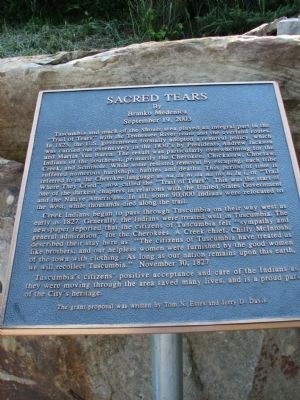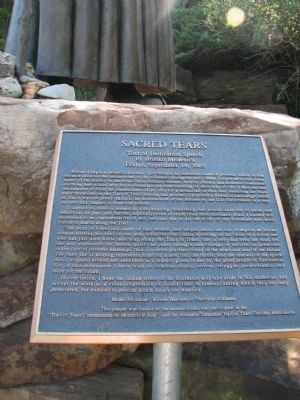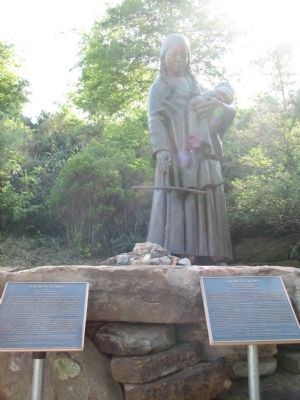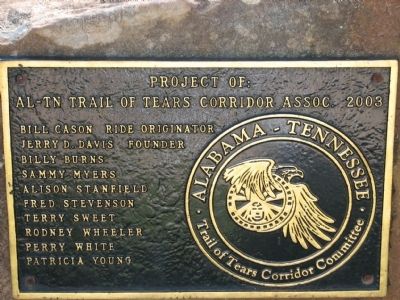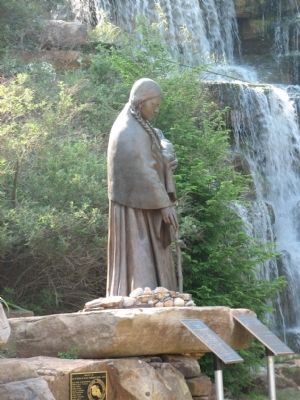Tuscumbia in Colbert County, Alabama — The American South (East South Central)
Sacred Tears
By Branko Medenica
— September 19, 2003 —
Panel 1
Tuscumbia and much of the Shoals area played an integral part in the "Trail of Tears" with the Tennessee River route and the overland routes. In 1825, the U.S. Government formally adopted a removal policy, which was carried out extensively in the 1830's by Presidents Andrew Jackson and Martin Van Buren. The result was particularly overwhelming for the Indians of the southeast, primarily the Cherokee, Chickasaw, Choctaw, Creek and Seminole. While some resisted removal by escaping, each tribe suffered numerous hardships, battles and deaths. This period of time is referred to in the Cherokee language as nu du hi du na tlo hi lu i, or "Trail Where They Cried", now called the "Trail of Tears". This was the start of one of the darkest chapters in relations with the United States Government and the Native Americans. In all, some 90,000 Indians were relocated to the West, while thousands died along the trail.
Creek Indians began to pass through Tuscumbia on their way west as early as 1827. Generally, the Indians were treated well in Tuscumbia. The newspaper reported that the citizens of Tuscumbia felt "sympathy and general admiration" for the Cherokees. A Creek chief, Chilly McIntos described their stay here as: “The citizens of Tuscumbia have treated us like brothers, and our helpless women were furnished by the good women of the town with clothing... As long as our nation remains upon this earth we will recollect Tuscumbia." November 30, 1827
Tuscumbia's citizens' positive acceptance and care of the Indians as they were moving through the area saved many lives, and is a proud party of the city's heritage.
Panel 2
Sacred Tears
Text of Dedication Speech by Branko Medenica
Friday, September 19, 2003
Before I begin a project like this, I go through an extensive research process, which in this instances involved the Indian tribes of the Southeast during the early 1800s. I try to delve into every aspect of the history of the tribes: their culture, customs, beliefs, politics, and economic conditions, anything that would help me to formulate an understanding of their way of life. I then use that information to form the embodiment of an idea for a memorial, in this case, depicting the trials and tribulations on the Trail of Tears. During this process, I acquired a wealth of knowledge, much of which was not pretty. In fact, the mistreatment of the Indians by the U.S. Government is a very sad and dark chapter in American History.
I wanted to create a memorial with meaning, something that would cause one to pause and reflect on the past, and maybe, hopefully, even to learn from those mistakes. Also, I wanted this memorial to be representative of not just one, but of all the tribes of the Southeast who were forced to march along the Trail.
The work is 8 feet tall, made of cast bronze, and weighs about one ton. It depicts an Indian woman holding her baby in one arm, while the other hand is resting on the cross of a loved one who has just died while marching along the Trail of Tears. She is very sad over the loss, yet she also represents the Indian spirit: the inner strength and courage to survive, to persevere in the face of extreme hardship. This is a noble attribute found in the heart and soul of the Indian. The baby she is holding represents hope for a new life, the future, and the renewal of the spirit. Also, wrapped around her shoulders is a blanket given to her by the good people of Tuscumbia. So, in this monument I have tried to combine death, sorrow, struggle, perseverance and hope for the future.
In conclusion, I hope the Indian tribes of the Southeast will take pride in the memorial, and accept the work as a visual expression of a dark time in history, during which they not only persevered, but endured to provide a rich legacy for America.
Erected 2003 by This Plaque was funded by the motorcyclists who participate in the “Trail of Tears Commemorative Motorcycle Ride” and the Alabama ~Tennessee Trail of Tears Corridor Association.
Topics and series. This historical marker is listed in these topic lists: Government & Politics • Native Americans. In addition, it is included in the Former U.S. Presidents: #08 Martin Van Buren, and the Trail of Tears series lists. A significant historical date for this entry is September 19, 2003.
Location. 34° 43.791′ N, 87° 42.172′ W. Marker is in Tuscumbia, Alabama, in Colbert County. Marker is at the intersection of South Main Street and Spring Park Road, on the left when traveling south on South Main Street. Located in Spring Park near the Waterfall and in front the Indian Maiden. Touch for map. Marker is in this post office area: Tuscumbia AL 35674, United States of America. Touch for directions.
Other nearby markers. At least 8 other markers are within walking distance of this marker. Cold Water Falls (within shouting distance of this marker); Jackson's Military Road (within shouting distance of this marker); Petrified Conifer Tree / Petrified Lycopod Tree Stump (within shouting distance of this marker); Tuscumbia Big Spring (about 300 feet away, measured in a direct line); History of Tuscumbia, Alabama (about 600 feet away); American Indian History (about 700 feet away); U. S. Army M60A3 Main Battle Tank (about 700 feet away); Tuscumbia Railway First Railroad west of Alleghenies (approx. ¼ mile away). Touch for a list and map of all markers in Tuscumbia.
Credits. This page was last revised on October 31, 2019. It was originally submitted on March 29, 2010, by Sandra Hughes Tidwell of Killen, Alabama, USA. This page has been viewed 3,067 times since then and 108 times this year. Last updated on May 18, 2015, by J. Makali Bruton of Accra, Ghana. Photos: 1, 2, 3, 4, 5. submitted on March 29, 2010, by Sandra Hughes Tidwell of Killen, Alabama, USA. • Bernard Fisher was the editor who published this page.
